Introduction
- Walmart: a well-known U.S. retail company;
- Large presence in the U.S. retail market;
- Necessity to expand into other markets;
- India and Brazil as the markets with the greatest potential;
- Opportunities for attracting new customers.
Walmart has built quite a reputation for itself, with years of functioning in the retail industry. However, due to the need to improve and expand into the digital setting, the organization will need to search for expansion options (Law, 2016). The current opportunities include India and Brazil, where workforce is significantly cheaper, and where Walmart can gain the loyalty and attention of new buyers.
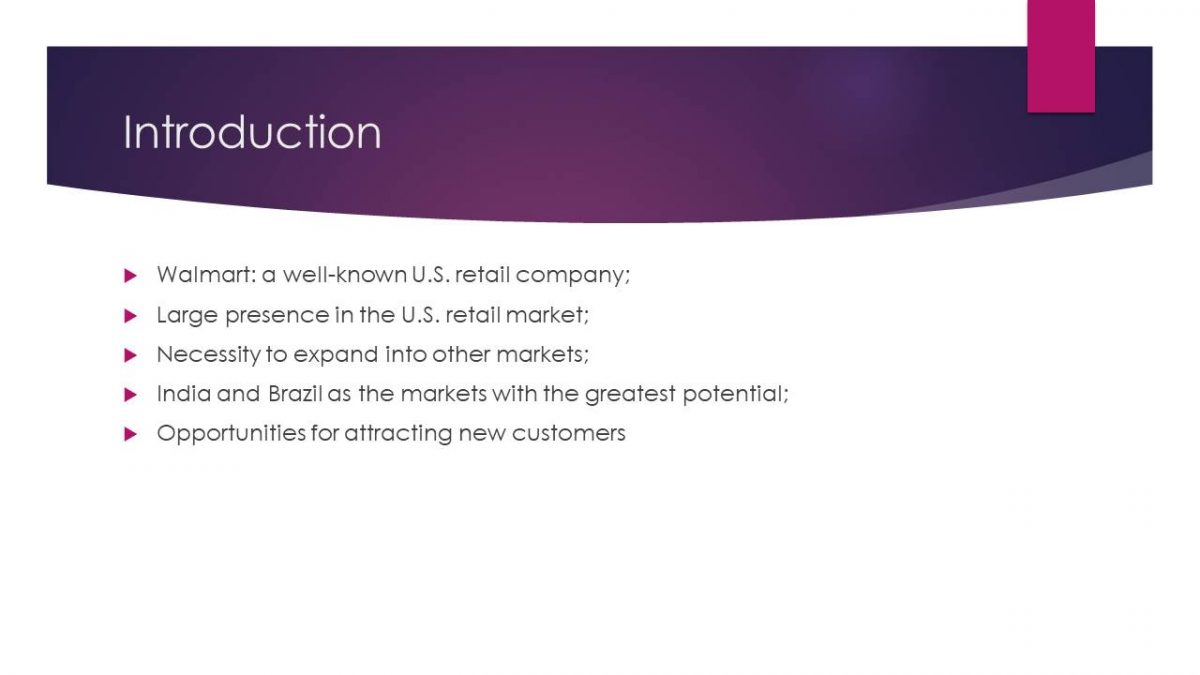
Current Competitive Advantage: Description
- Walmart’s present-day image: medium-quality products for the lowest price imaginable;
- Key competitive advantage: the most affordable price-to-quality ratio;
- Result: high levels of popularity among American buyers (Aydin, 2015).
Walmart has been positioning itself as the organization with the lowest possible price-to-quality ratio. Therefore, the cheapness of products has been attracting customers to Walmart for years (Burgess, 2016). However, in order to become more resilient in the global environment, the firm will need to integrate a new approach into its functioning not only to become distinguishable from other companies but also to show that it has evolved. Therefore, changes to the current competitive advantage are required.
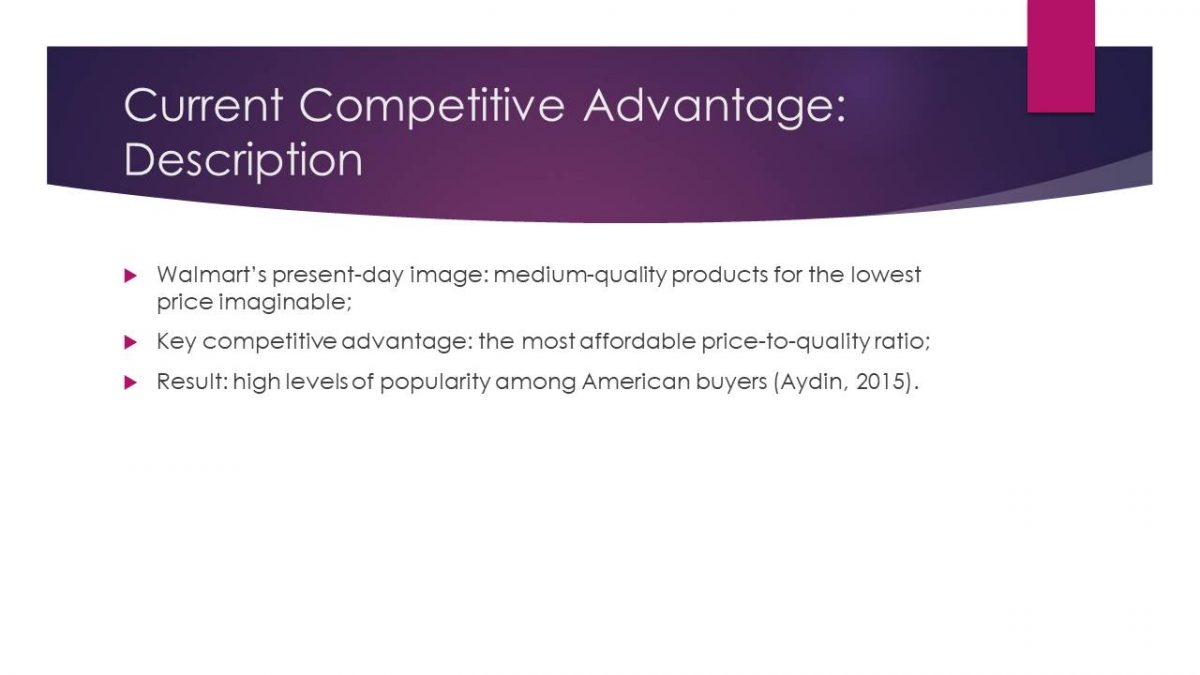
Strategic Initiative Plan: Summary
- Integrating into the Indian and Brazil markets;
- Including innovation-based principles into the corporate philosophy;
- Focusing on creating a conformable workplace setting.

The strategic initiative plan for Walmart currently implies integrating the company into the Indian and Brazilian economic environment. In order to perform the specified task, the company will have to alter its current marketing framework to position itself not only as the cheapest retailer available but also as an innovative organization that strives to meet its customers’ requirements and create a comfortable workplace environment for its staff (Law, 2016).
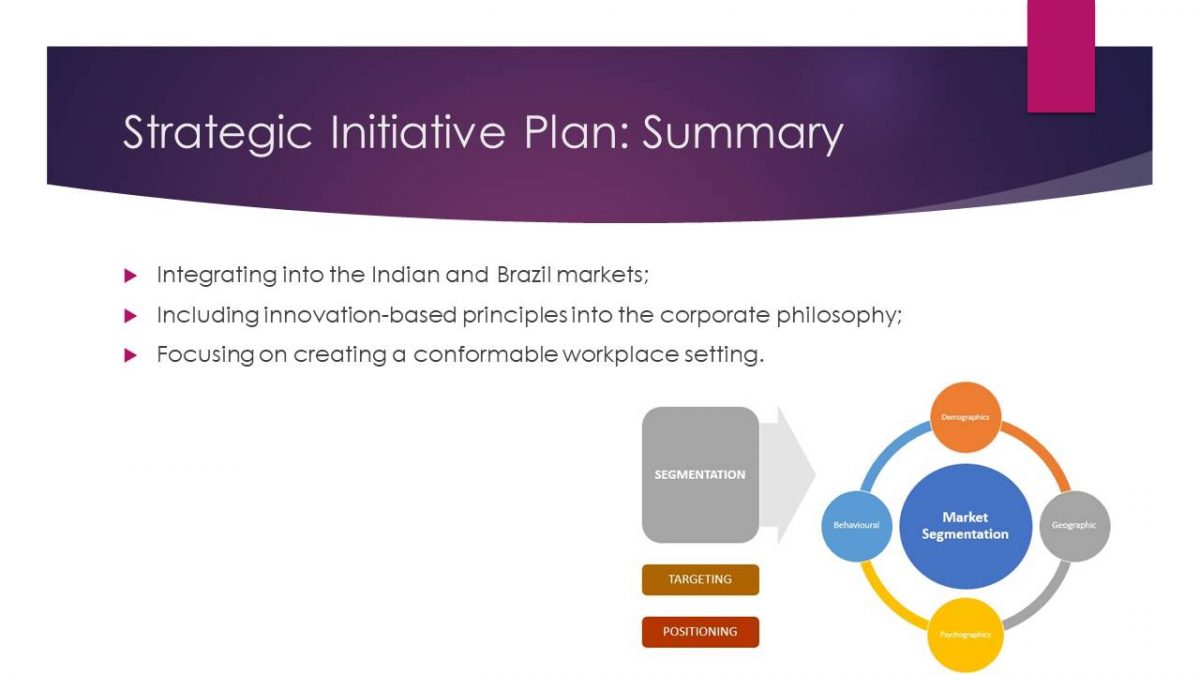
Competitive Advantage and Strategic Initiative Plan
- Current competitive advantage: price-quality correlation;
- Necessity to change the competitive advantages;
- Use of initiative and innovation as the basis;
- Promoting change on the corporate level;
- Integrating a multicultural approach into the process.
The designed strategic initiative plan (SIP) allows maximizing Walmart’s competitive advantage since it will help the organization to introduce innovative solutions and a stakeholder-focused approach into its functioning. The resulting increase in the options for minimizing expenses, promoting sustainable solutions, and improving staff’s performance will lead to higher quality along with more affordable prices (Law, 2016). In addition, the incorporation of a multicultural approach will help Walmart to outsource cheaper workforce in Brazil and India.
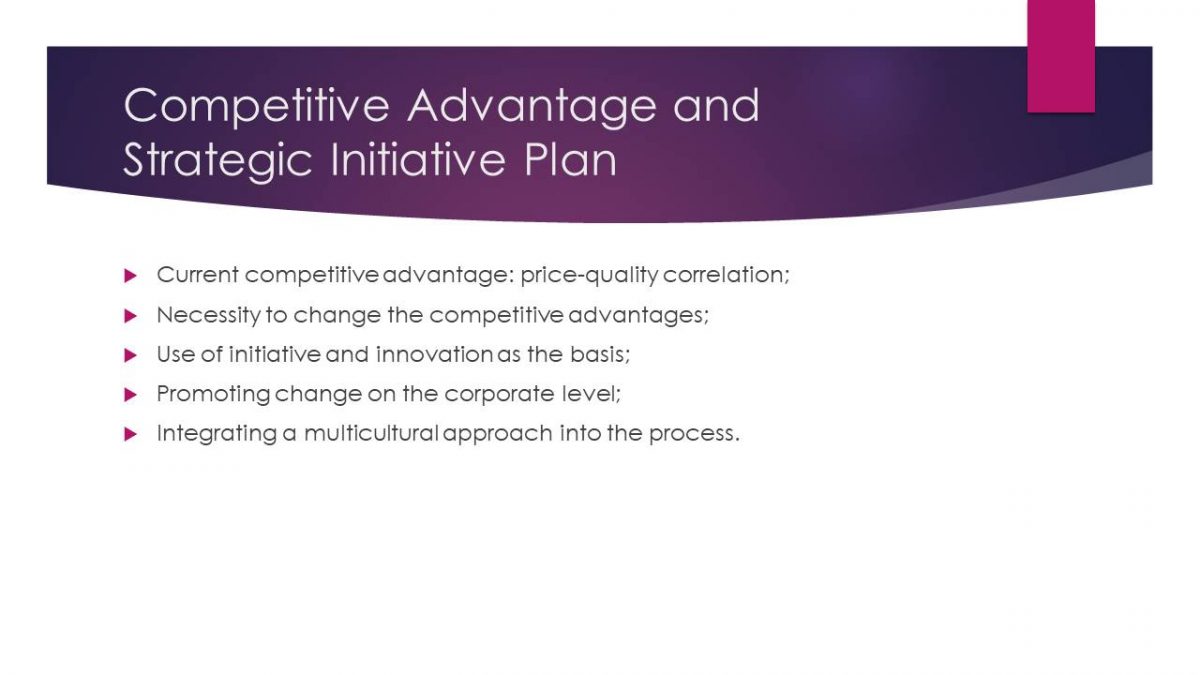
Walmart’s Mission: Greater Social Good (A Christian Perspective)
Walmart’s mission
- Appreciation for the staff’s culture;
- Meeting the needs of culturally diverse stakeholders;
- Keeping all participants of the communication satisfied;
- Ensuring that conflicts are resolved objectively.
Christian values
- Love for one’s neighbor;
- Unconditional love;
- Refutation of vengeance;
- Forgiveness of sins (Conrad & Thompson, 2016).
The idea of tending to the cultural needs of all stakeholders and focusing on an innovative approach toward communication and decision-making aligns with the existing Christian principles perfectly. Specifically, these principles are linked to the idea of loving one’s neighbor, or, in a broader sense, the respect and appreciation for people around us (Conrad & Thompson, 2016). Indeed, by using the specified principles, one will be capable of communicating more effectively and showing concern for the needs of others, particularly, the company’s staff.
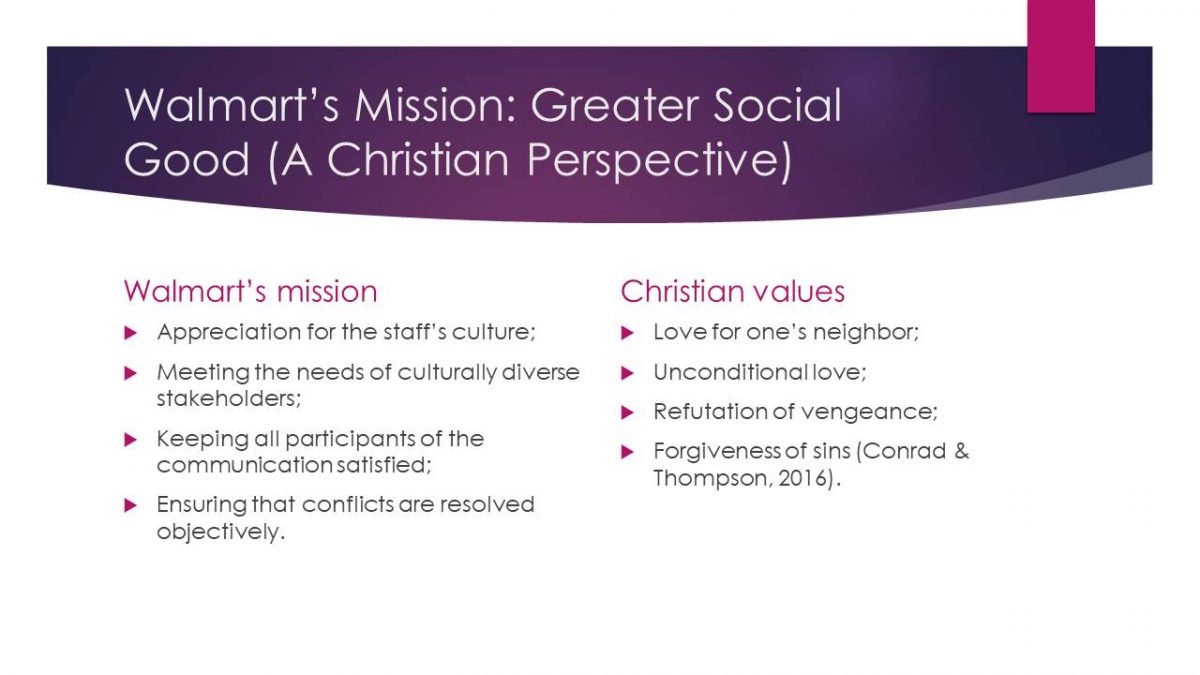
Walmart’s Vision: Greater Social Good (A Christian Perspective)
- Intersection between the Christian concept of love and Walmart’s idea of inclusion;
- Focus on promoting the culture of empathy as a possible interpretation of love for one’s neighbor;
- Building appropriate workplace conditions for employees as the manifestation of love for others.
The company’s vision, which includes the global well-being, is also tied directly to the principal Christian values, such as inclusion, promotion of the culture of empathy in the modern community, and the creation of decent living conditions for people (Law, 2016).
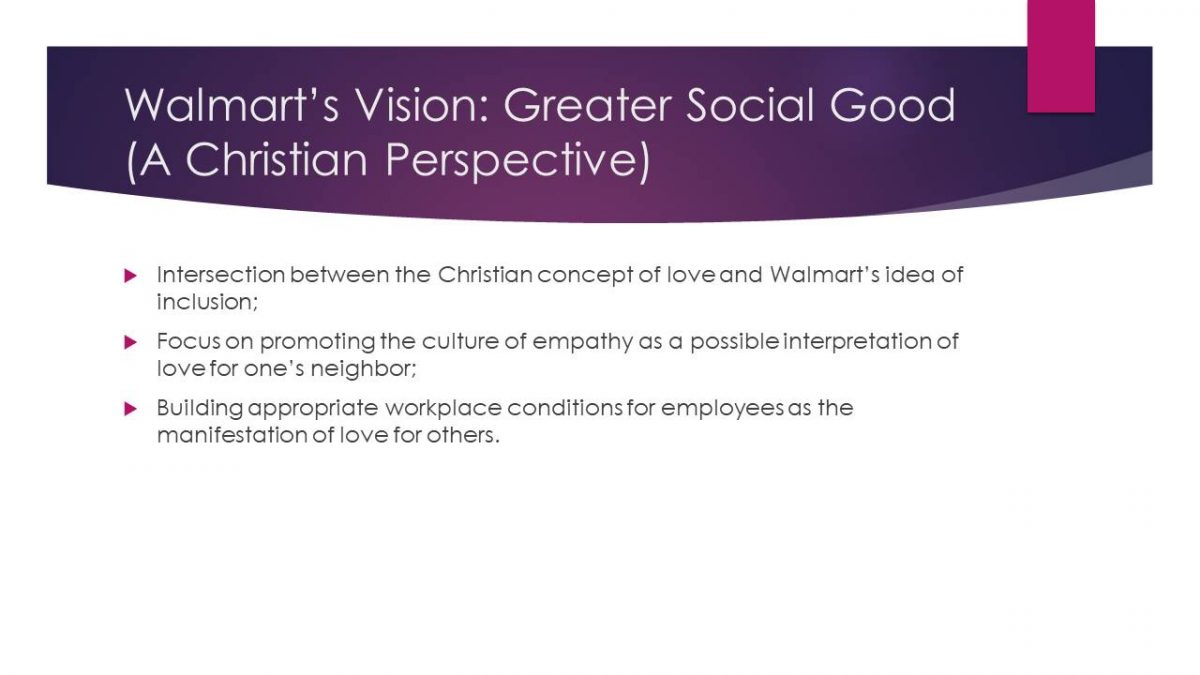
Accommodating Walmart’s Responsibilities
- Shift in the corporate values;
- Promotion of a corporate philosophy based on Christian ideas;
- Integration of the concept of diversity;
- Focus on communication and care for stakeholders’ feelings.
In order to accommodate the firm’s responsibilities for the promotion of Christian values through its action plan, Walmart will need to reconsider its philosophy and values. The shift in the perception of the needs of others is critical in the redesign of the firm’s current approach toward its responsibilities (Law, 2016).
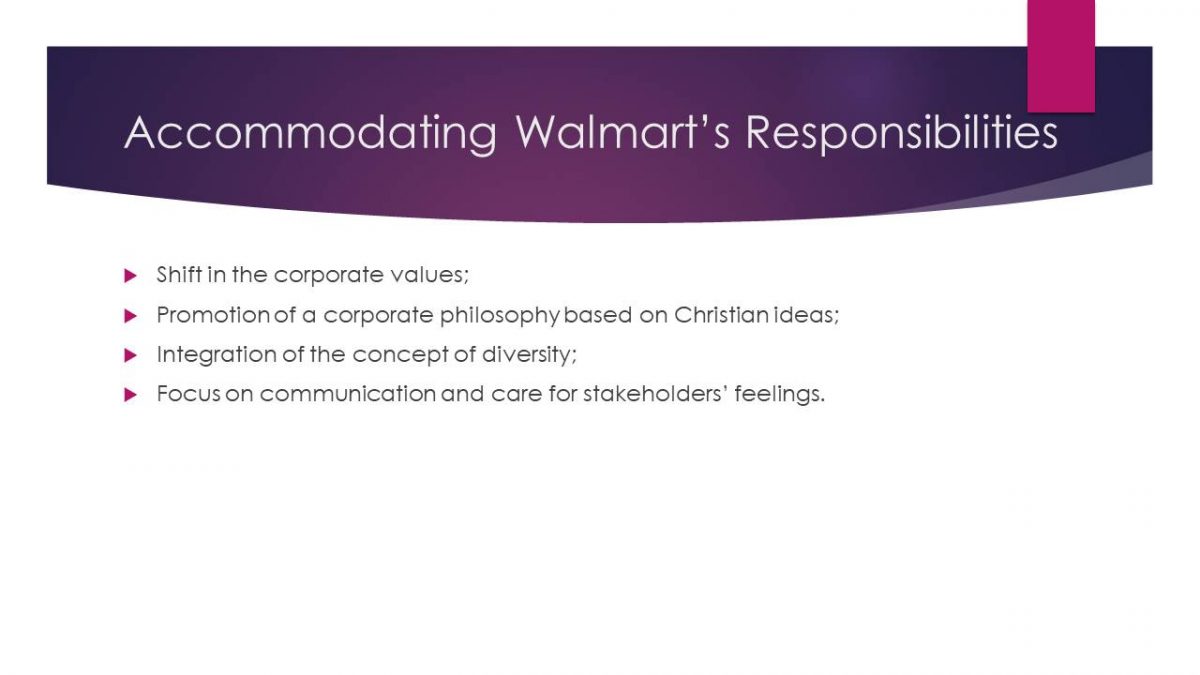
Action Plan and Ethical Considerations
- Integrity across the organization due to a unified system of values;
- Honesty and fairness achieved with the help of transparency within the firm;
- Respect and concern for all participants involved based on the idea of empathy;
- The culture of empathy as the gateway to increasing loyalty;
- Law-abiding as the cornerstone principle.
The plan designed for Walmart also allows addressing ethical concerns by addressing culture-specific needs of its staff members. While the current approach does not allow the company to consider the personal needs of its staff, a stakeholder-focused approach will (Law, 2016).
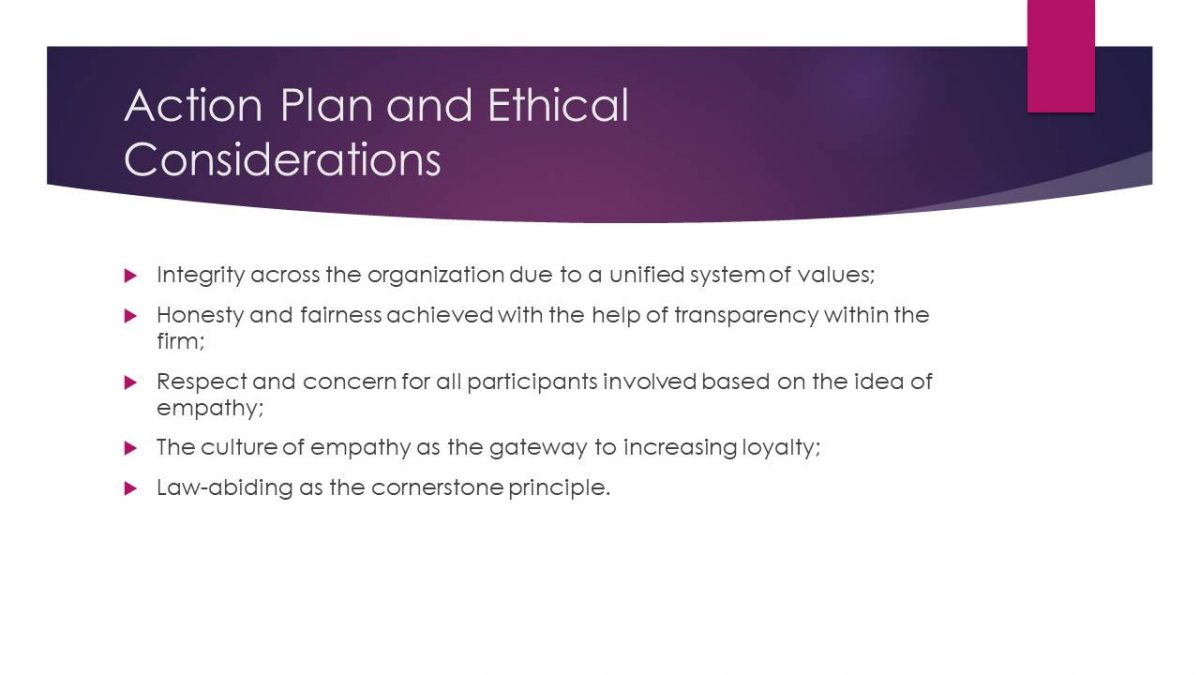
Action Plan and Corporate Social Responsibility
- Corporate Social Responsibility (CSR): concept of corporate accountability;
- Promotion of CSR at Walmart: an employee-focused approach;
- Public good and well-being: a vehicle for promoting CSR at Walmart;
- Integration of stakeholder-oriented values for decision-making: basis for CSR.
The suggested action plan also implies a change in the perception of staff’s responsibilities. While Walmart will seek to address their personal needs, employees are also expected to develop Corporate Social Responsibility (CSR). CSR will be achieved due to the emphasis on the public good and well-being (Law, 2016).
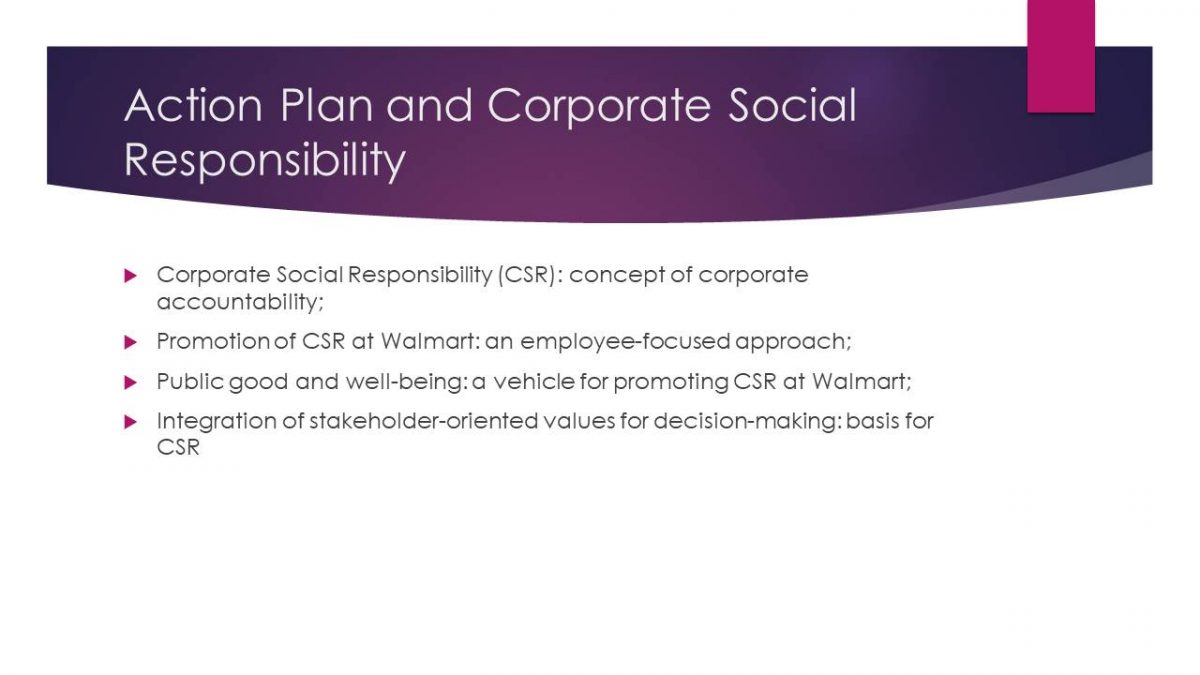
Action Plan and Sustainability
- Current action plan: focus on sustainable performance;
- More elaborate use of resources due to the focus on environmentalism;
- Environmentally safe production promoted by the introduction of innovative tools;
- Use of the principles of proper waste management and reduction in the levels of waste.
The designed action plan is also expected to have a direct effect on the levels of sustainability within the organization. By changing the current framework toward the one that is geared toward innovations and a stakeholder-oriented approach, one will create the platform for environmentalism and sustainable use of resources (Law, 2016). Specifically, the decisions made within the context of the company will take environmental concerns such as proper waste management and resource use into account.
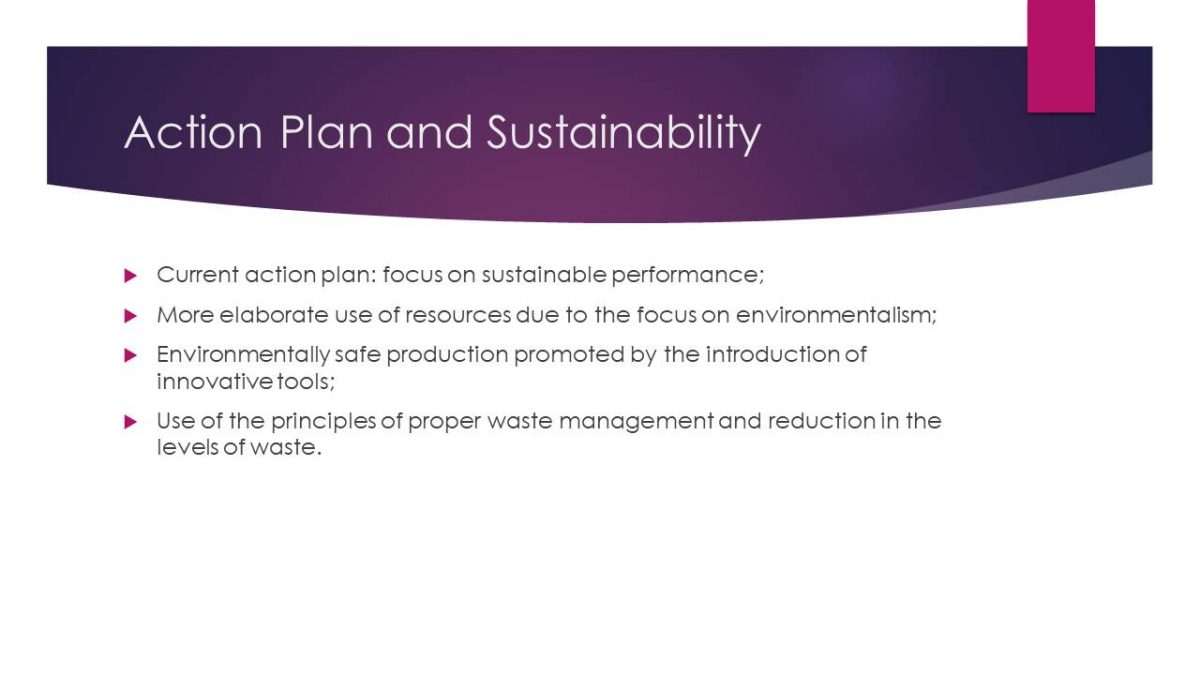
Action Plan: Using Leadership Skills to Promote Innovation
- Using the transformational leadership style as the key framework;
- Motivational skills: encouraging employees to accept innovative thinking and develop new competencies;
- Negotiation skills: addressing possible resistance to change among staff members;
- Conflict management: introducing an objective approach toward handling misunderstandings;
- Communication skills: conveying new ideas to employees and listening to their feedback;
- Educational skills: helping staff members to acquire new competencies.
In order to launch the process of innovation-driven change at Walmart, one will have to use appropriate leadership skills. Since the current situation requires a change in the company’s value system and perspective, the transformational leadership approach should be used (Law, 2016). Specifically, a leader will have to motivate staff members, negotiate, address emergent conflicts, and introduce staff members to new roles and responsibilities, thus educating them.
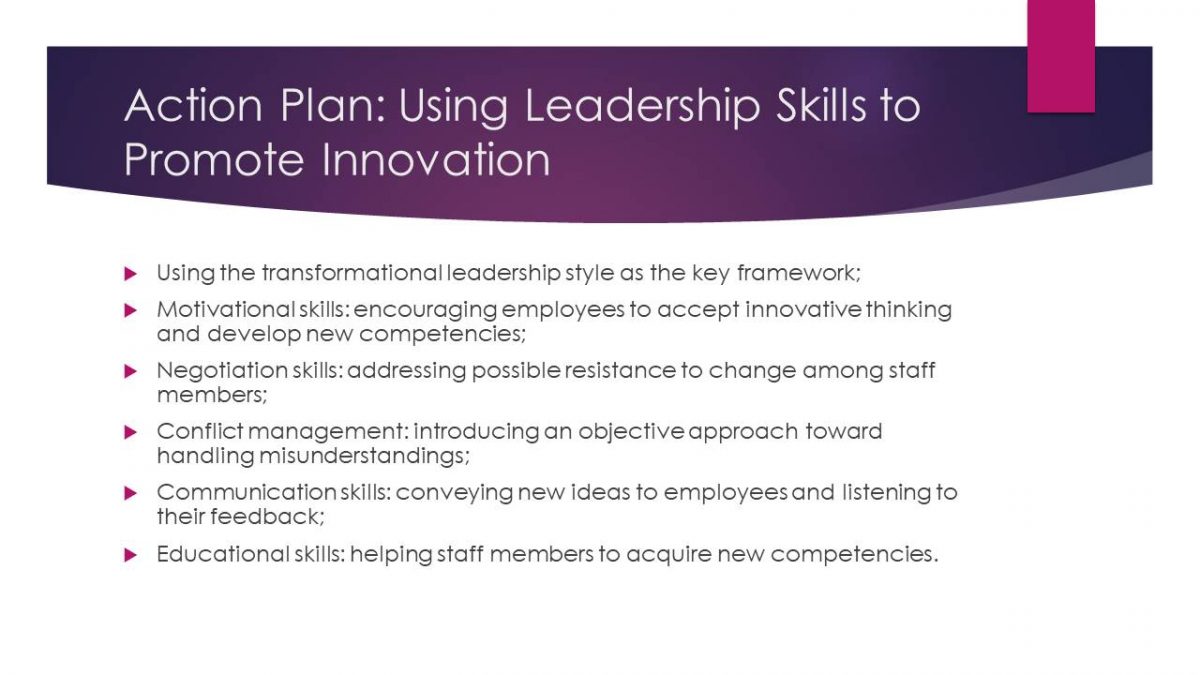
Strategic Plan: International Considerations
- Walmart: necessity to alter its marketing to appeal to new audiences;
- Brazilian market: emergence of the “new middle class” (Sengupta, Dutta, & Sen, 2018).
- Ability to purchase more expensive products and pursue better quality;
- Indian market: demand for luxury as a part of consumer culture (Sengupta et al., 2018);
- Adjusting marketing to appeal to buyers: change in the price-quality dynamics and branding approach.
In order to implement its action plan, Walmart should study some of the international considerations first. Since the organization plans to enter the Brazilian and Indian markets, it will need a cultural framework to apply in order to address possible issues, the marketing concerns being the key ones. The Brazilian market will require understanding the needs of the so-called “new middle class” (Sengupta et al., 2018). The Indian market, in turn, will demand considerations for luxury and high-quality products.
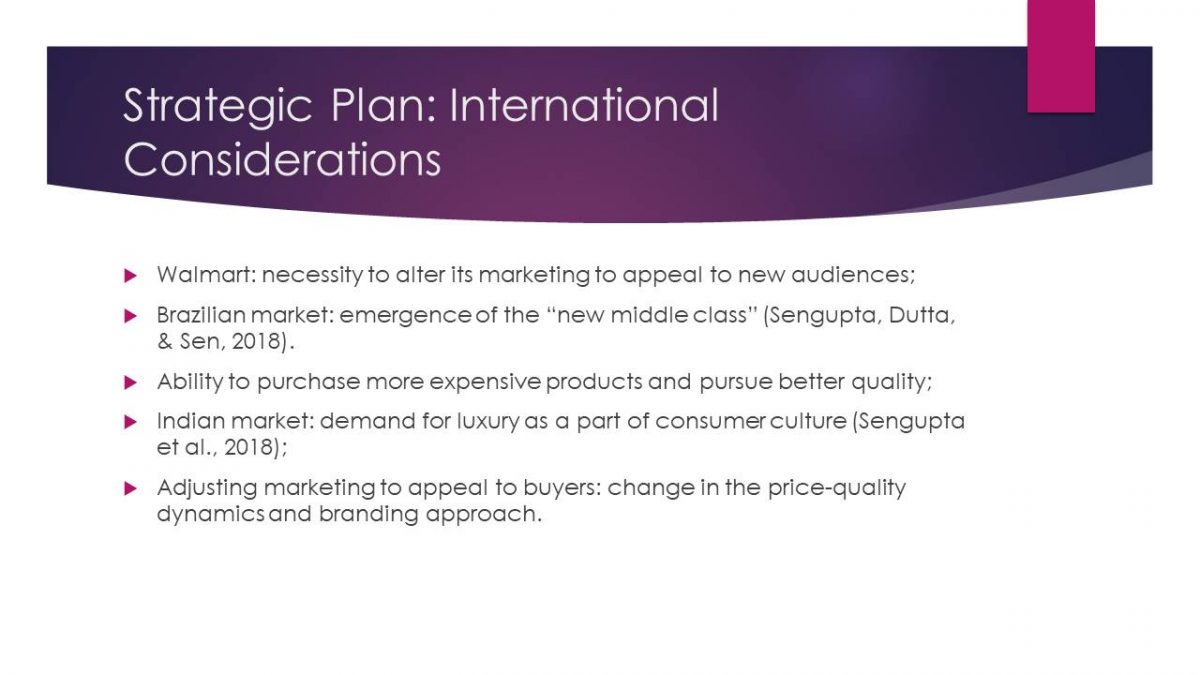
Strategic Plan: Global Considerations
- Retaining the brand image at all costs;
- Positioning itself as a company selling quality products;
- Making the lowest prices possible the key selling point.
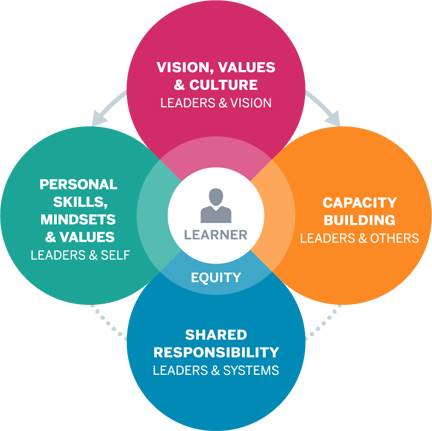
On a global scale, Walmart will need to maintain its image of a company that sells products of reasonable quality at the lowest price possible. While adjustments will have to be made to address the demand of the Brazilian and Indian markets, Walmart will have to retain its brand image (Law, 2016).

Addressing Risks
- Risk management strategy: allocating finances properly;
- Creating a working exit strategy in case of a failure;
- Exit strategy for the Brazilian market: search for a partnership;
- Exit strategy for the Indian market: a merger or an acquisition;
- Expected outcomes: an improved position in the target economy.
The risk management strategy that Walmart should deploy requires designing a proper exit strategy. To improve its performance in the Indian and Brazilian markets in case of a failure, Walmart should consider using a merger or an acquisition in the Indian setting and seeking opportunities for a partnership in the context of the Brazilian market (Rael, 2017).
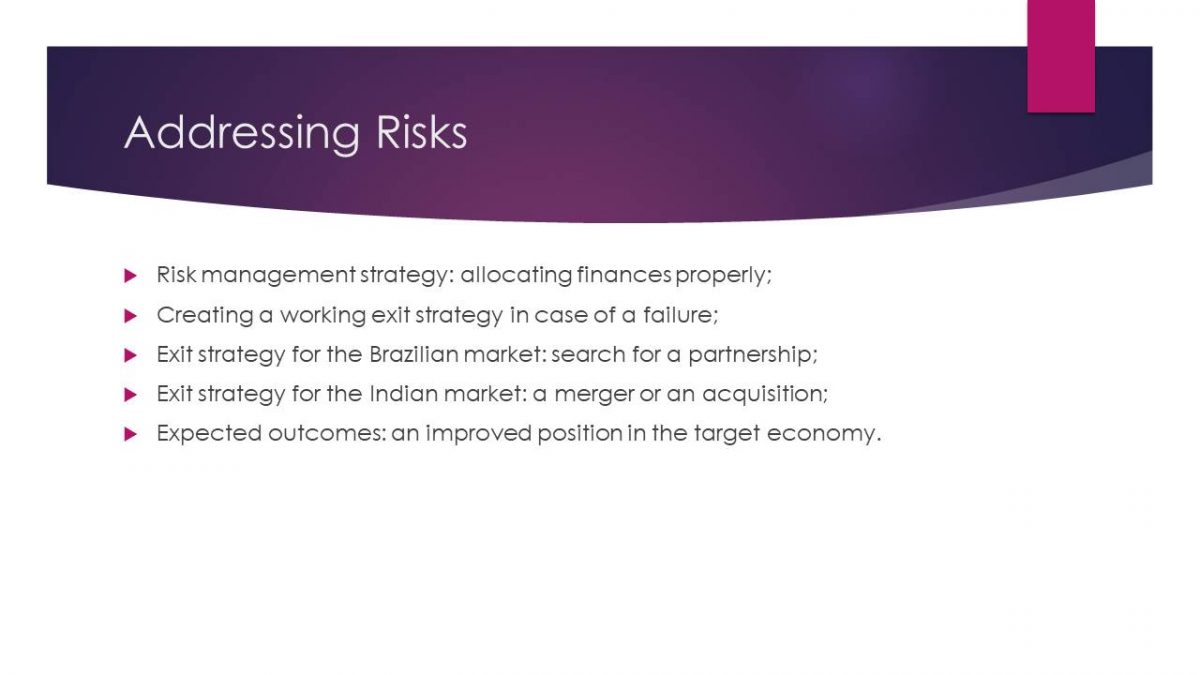
Connecting Marketing and Corporate Philosophy
- Focus on personal needs of stakeholders: addressing culture-specific needs of employees and customers;
- Exploration of the Brazilian and Indian cultural setting to address the needs of customers with improved services;
- Innovation-driven approach as the method of improving customers’ quality of life through product quality management.
The strategic plan that Walmart has to integrate into its current framework to enter the Brazilian and Indian retail markets also has to link marketing to changes in the corporate philosophy. For instance, the organization will need to recognize the individual needs of its staff members to improve the quality of services and research Indian and Brazilian culture to appeal to new clients (Law, 2016).
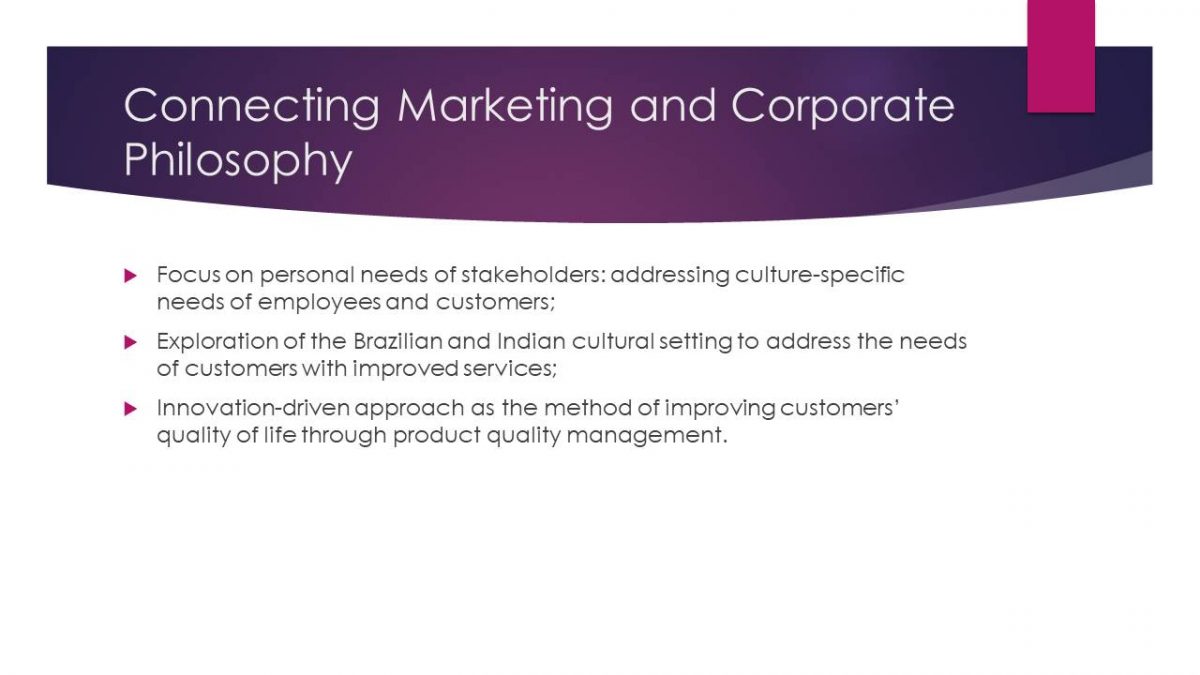
Promoting Diversity on a Corporate Level
- Diversity culture: one of the critical components of the action plan;
- Use of diversity principles to encourage cooperation in the workplace;
- Enhancement of diversity culture to meet employees’ needs;
- Incorporation of diversity principles into marketing and branding in the Indian and Brazilian markets.
The enhancement of diversity culture will become another aspect of implementing the action plan. By using the principles of diversity, Walmart will become capable of addressing its employees’ culture-specific needs and introduce new benefits Similarly, the demands of Brazilian and Indian customers will be met more effectively once a diversity-geared framework is incorporated (Law, 2016).
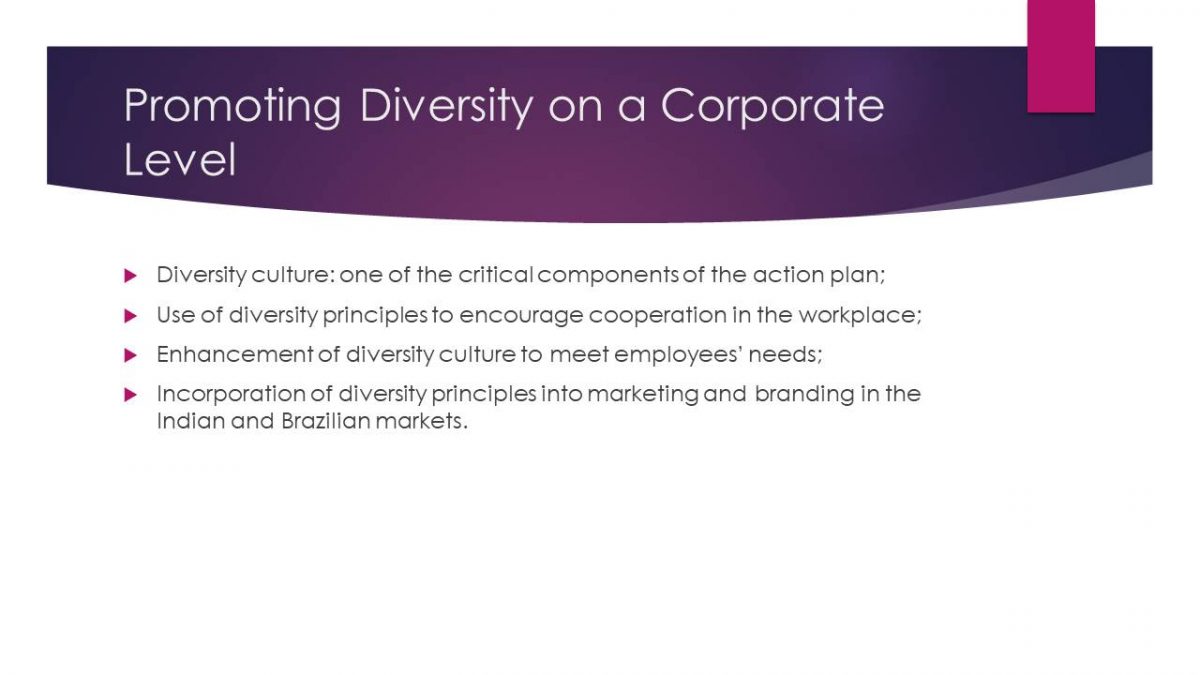
Integrating Innovation-Based Decision-Making
- Innovation as one of the pillars of the corporate philosophy;
- Innovative thinking in promoting corporate values;
- Innovative approach toward decision-making;
- Using non-incremental innovations to explore new opportunities.

Among the key changes that the improved corporate philosophy will entail, the promotion of innovation-driven decision-making is the key alteration. The specified aspect of the action plan implies the company’s transfer to a new framework for making choices regarding the organization’s functioning in the selected markets. Specifically, IT and ICT tools will be used to gather relevant data and innovative ideas in marketing and quality management will be incorporated to ensure customer satisfaction (Law, 2016).
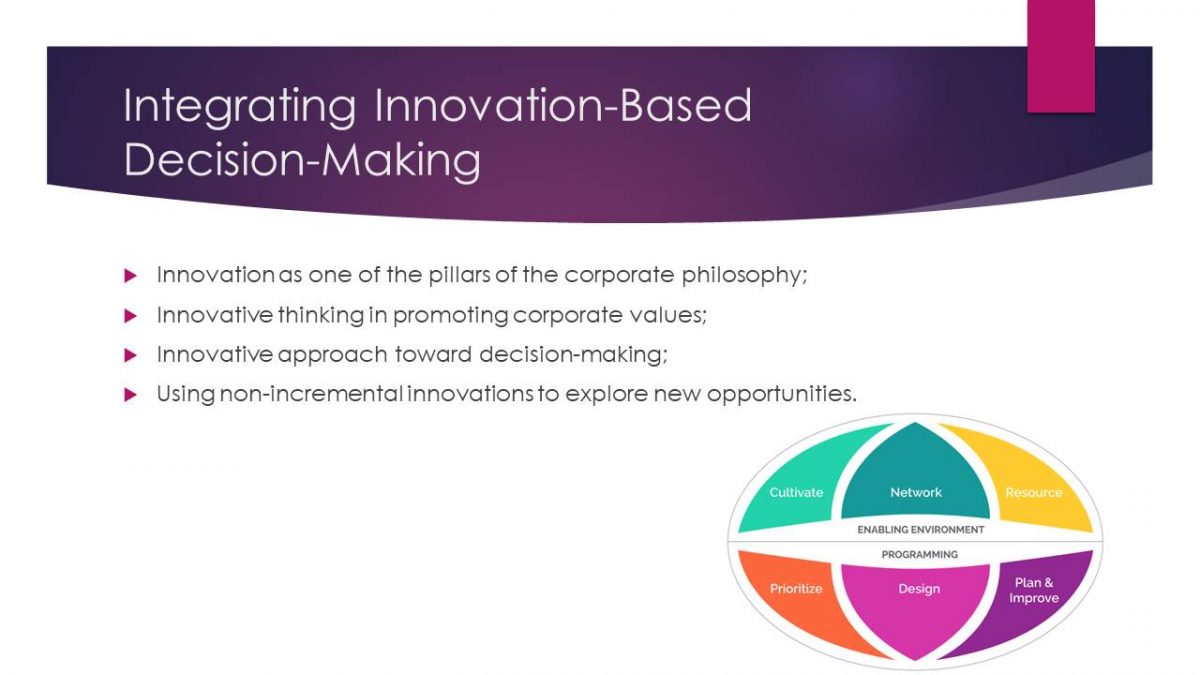
Encouraging Professional Growth
- Improved corporate philosophy: meeting the needs of all participants;
- Addressing employees’ need for professional development;
- Creating courses for acquiring new competencies and skills;
- Using outsourcing as the method of knowledge sharing.
Walmart will also need to use its renewed corporate philosophy to invest in the development of its employees. Particularly, Walmart should introduce opportunities for training and acquisition of new competencies for its staff. The specified change will align with the organization’s idea of meeting stakeholders’ needs and at the same time improving service quality (Law, 2016).
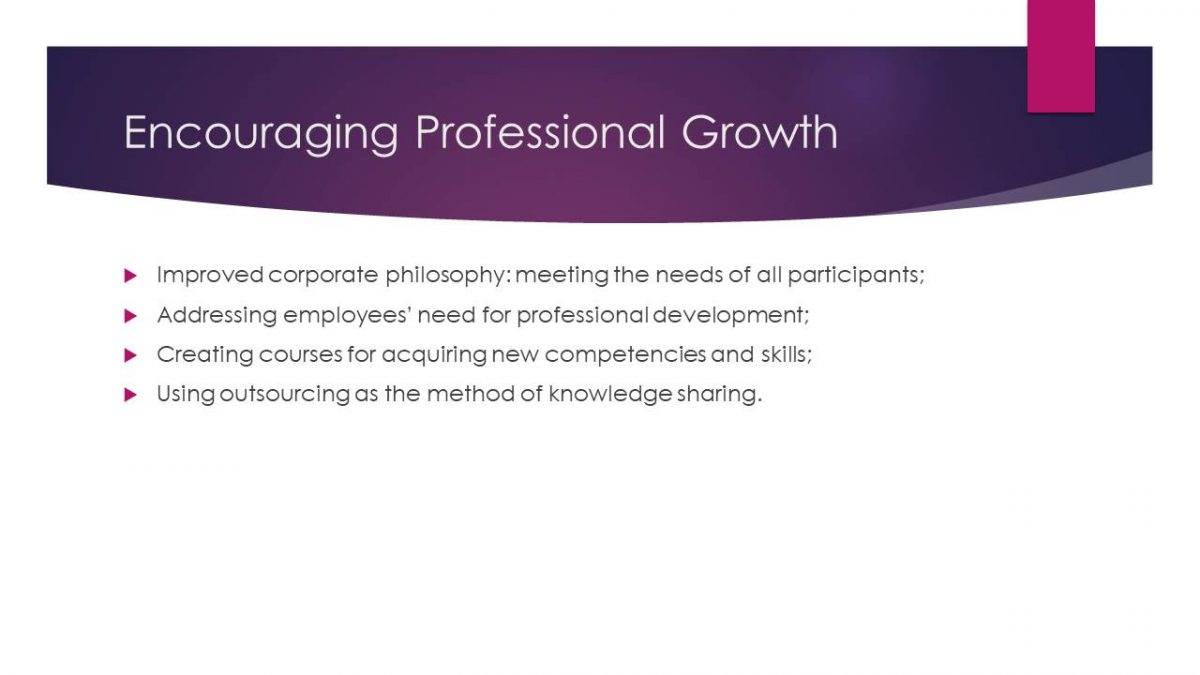
Competitive Advantage: Adding New Elements
- Crucial note: keeping the core of the original competitive advantage intact;
- Integrating new ideas into the competitive advantage to appeal to Indian and Brazilian markets;
- Incorporating diversity to show appreciation for new buyers and their needs;
- Understanding social and economic changes in the Indian and Brazilian markets.
In order to succeed in the selected environments, Walmart will need to reconsider its approach toward developing a competitive advantage. The firm should continue to use the concept of the most affordable quality-price correlation. At the same time, it should introduce the idea of diversity and flexibility into its brand, making it appealing to the Indian and Brazilian markets (Law, 2016).
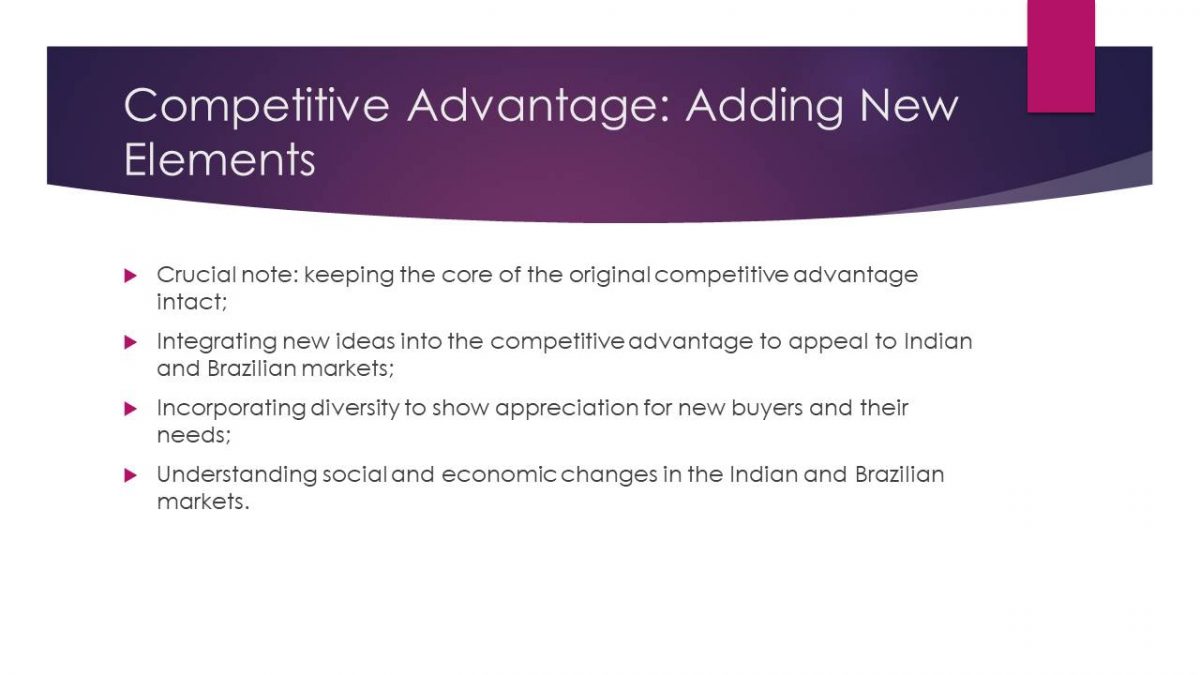
Expected Outcomes
- Introducing Walmart to the environment of Indian and Brazilian retail sectors;
- Establishing Walmart as an influential organization in the selected markets;
- Gaining the attention of Indian and Brazilian customers;
- Attracting possible investors and partners;
- Improving the general rates of Walmart’s performance.
It is believed that the proposed technique will allow the organization to thrive in the new markets. By connecting the idea of innovative thinking and problem-solving to the concept of diversity and using reciprocal communication to encourage change, Walmart can make a difference in the Indian and Brazilian retail sectors. Furthermore, a positive dynamics in Walmart’s profits is expected (Law, 2016).

Recommendations
- Enhancing the present risk management approach;
- Studying the investment opportunities in India and Brazil;
- Searching for partnerships in the Indian setting;
- Locating possible acquisitions and mergers in the Brazilian retail market;
- Promoting active communication with all stakeholders (using IT and ICT tools).
It is strongly recommended that the organization should analyze all available opportunities for risk management. Seeking possible investment options in India and Brazil should also be regarded as important. Finally, the search for possible partnerships and mergers is a crucial step (Law, 2016).

Conclusion
- Walmart: strong urgency to enter new markets;
- Strong presence in the American market;
- Poor levels of recognition in the global setting;
- Indian and Brazilian markets: target environment;
- Current action plan: focus on CSR- and people-oriented values;
- Reinforcement of ethical and Christian values;
- Active promotion of communication within the firm;
- Attention to culture-specific needs of employees and customers.
Walmart has become quite powerful in the U.S. market, yet it desperately needs to gain recognition in other economies. For this purpose, the company should explore the Indian and Brazilian retail markets. By changing its value system and marketing, Walmart will integrate into the target economies successfully.

References
Aydin, N. (2015). Benefits of Global Sustainability. Benefits, 4(4), 9-12.
Burgess, B. (2016). Driving B2B growth with account-based marketing. Market Leader, 1, 45-47.
Conrad, C., & Thompson, M. (2016). The new brand spirit: How communicating sustainability builds brands, reputations and profits. Chicago, IL: CRC Press.
Law, J. (2016). A dictionary of business and management. Oxford, UK: Oxford University Press.
Rael, R. (2017). Smart risk management: A guide to identifying and calibrating business risks. New York, NY: John Wiley & Sons.
Sengupta, S., Dutta, U. S., & Sen, A. (2018). Re-inventing household shopping patterns and buying roles: Exploring the “new women” in urban India. AKADEMOS, 263(1), 263-284.